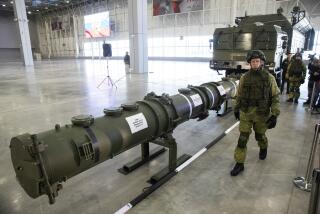Trump’s decision to exit arms treaty with Russia could free the U.S. to put new missiles in Asia
- Share via
Reporting from Washington — President Trump says he is withdrawing from a landmark Cold War-era arms treaty with Russia because Moscow has been violating the agreement for years.
But scrapping the 1987 Intermediate-Range Nuclear Forces Treaty also serves another key Trump goal: intensifying military pressure on China.
Because Beijing is not a signatory to the agreement, it has been able to build an extensive arsenal of medium-range ballistic missiles armed with conventional warheads. It’s a stockpile that now threatens U.S. air bases and aircraft carriers central to the Pentagon strategy for defending allies in Asia.
If Trump follows through on his vow to withdraw from the treaty, the Pentagon would be free to deploy medium-range missiles in Asia capable of hitting targets in China, current and former officials say. Unless Russia and China agree to a new agreement, Trump has said, “we are going to develop the weapons.”
Abrogating the treaty could come at a high price, however. It would risk intensifying a growing U.S. military rivalry with Beijing and Moscow, both of which are likely to deploy new weapons to counter any U.S. buildup, critics say.
“Withdrawing from the treaty will open the door to a new and unconstrained competition,” said Lisbeth Gronlund, co-director of the Global Security Program at the Union of Concerned Scientists, an arms-control group based in Washington.
Exiting the treaty has long been a goal of Trump’s national security advisor, John Bolton, a longtime critic of arms-control agreements who traveled to Moscow this week to explain the U.S. decision to Russian officials.
At a news conference Tuesday in Moscow, Bolton brushed off mounting concerns from China and European allies — as well as Russia — that U.S. withdrawal from the treaty would undermine global security. Bolton quipped that he would say the same thing if he were living in Beijing.
“In the case of China, one-half to one-third of their ballistic missile capability would violate the treaty if they were party to it,” Bolton said.
In 2011, Bolton argued in a Wall Street Journal opinion piece that the U.S. should either expand the treaty to cover China or “abrogate it entirely so that we can rebuild our own deterrent capabilities.”
A Pentagon report on China’s military capabilities released in August said Beijing had conventionally armed short- and medium-range ballistic missiles as well as ground- and air-launched land-attack cruise missiles.
The U.S. is especially concerned about China’s DF-26, an intermediate-range ballistic missile fielded in 2016 that has a maximum range of 2,500 miles, enabling it to strike U.S. bases as far away as Guam.
“We are at a disadvantage with regard to China today in the sense that China has ground-based ballistic missiles that threaten our basing in the western Pacific and our ships,” Adm. Harry Harris, former head of U.S. Indo-Pacific Command, who is now ambassador to South Korea, told the Senate Armed Services Committee in March.
He added: “We have no ground-based capability that can threaten China because of, among other things, our rigid adherence — and rightfully so — to the treaty that we signed on to, the INF treaty.”
The Pentagon would by no means be helpless if war broke out with China. U.S. warships and attack submarines carry highly accurate Tomahawk cruise missiles, while its warplanes are armed with air-to surface missiles that can hit targets hundreds of miles away.
Air Force Gen. Paul Selva, vice chairman of the Joint Chiefs of Staff, told Congress in July 2017 that there was no military necessity to withdraw from the treaty because the U.S. already had the capability to hit sufficient targets in China using air- and sea-based missiles.
Both types of weapons could strike targets on the Chinese mainland from far offshore, fired from ships and planes that can move around, making them harder for the Chinese to target. The treaty only covers missiles based on land, leaving the U.S. free to deploy as many sea- and air-based missiles as it chooses.
But some experts say basing medium-range cruise missiles on land in Asia would significantly increase the Pentagon’s ability to constrain China, deterring Beijing from using force to reclaim control over Taiwan or the Senkaku Islands, an archipelago in the Western Pacific controlled by Japan but claimed by China.
Putting missiles in Japan or Guam is “another way to enhance the deterrent capability,” said Eric Sayers, a former consultant to U.S. Indo-Pacific Command and an adjunct fellow at the Center for a New American Security, a Washington think tank.
“The goal is to be able to deter them from thinking that this month or this year is a good time to move on Taiwan or the Senkakus,” he added.
At best, it will take years for the U.S. to put this strategy into practice. Because of the treaty restrictions, the U.S. has gotten rid of medium-range missiles in its arsenal. Its quickest path to reconstitute the capability would be to modify existing cruise missiles so they could be fired from mobile launchers.
“Every dollar spent on treaty-prohibited missiles in Asia is a dollar not spent on what in my view are superior treaty-compliant air- and sea-based cruise missiles — where we have a greater advantage,” said Kingston Reif, director for disarmament and threat reduction policy at the Arms Control Assn., an anti-proliferation policy organization.
The U.S. would also have to convince Japan or other close allies in Asia to agree to have the missiles based on their territory, a potentially difficult task, since it could make the host country a target of Chinese missiles if war broke out.
Japan’s chief cabinet secretary, Yoshihide Suga, said Monday at a news conference in Tokyo that the United States’ withdrawal from the treaty would be “undesirable,” adding, “We hope that it will be averted.”
Special correspondent Matthew Bodner in Moscow contributed to this report.
Twitter: @davidcloudLAT
More to Read
Sign up for Essential California
The most important California stories and recommendations in your inbox every morning.
You may occasionally receive promotional content from the Los Angeles Times.











